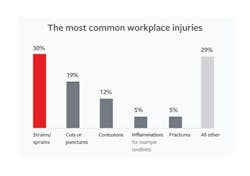Businesses spend $170 billion per year on costs associated with occupational injuries and illnesses (according to OSHA) – and these findings provide critical insight on how the numbers add up. Of all public sector and private US businesses, roughly 3.7 million workers are injured per year.
The Travelers Companies Inc., the country’s largest workers’ compensation carrier, released its Injury Impact Report, which identifies the most common causes of workplace accidents and injuries.
Travelers analyzed more than 1.5 million workers’ compensation claims filed between 2010 and 2014 from a variety of business sizes and industries and discovered that the most frequent causes of workplace injuries included:
- Material handling (32 percent of total claims);
- Slips, trips and falls (16 percent);
- Being struck by or colliding with an object (10 percent);
- Accidents involving tools (7 percent); and
- Traumas occurring over time, for example when a part of the body is injured by overuse or strain (4 percent).
The above incidents most often resulted in strains, sprains, cuts, punctures, contusions, inflammation, fractures or chronic sicknesses resulting from a type of work (e.g., a skin disease caused by chemical exposure). On average, strains and sprains resulted in 57 missed work days, followed by cuts and punctures at 24 days. Of the most common injuries, inflammation and fractures caused the most time away from work at 91 and 78 days, respectively.
“Even seemingly minor injuries, such as strains or sprains, can substantially impact an employee and slow a business’s operations and productivity,” said Woody Dwyer, second vice president, Workers’ Compensation, Risk Control, Travelers. “The most common injuries we see can often be prevented if the proper safety measures are in place, if safety issues are promptly addressed and if leaders continuously emphasize a culture of safety with employees.”
Industry-Specific Findings
Analysis of the workers compensation claim data revealed that certain causes of accidents and resulting injuries were more prevalent in some industries than others.
While material handling accidents were the top cause of injuries overall, these especially were common in the manufacturing and retail industries, causing nearly 40 percent of injuries in both sectors.
Falling from height was among the top causes of injuries in both the construction and retail industries. The oil and gas industry was the only segment in which motor vehicle accidents were one of the most frequent causes of injury. Eye injuries were one of the most frequent types of injuries in manufacturing and construction.
The injuries with the highest average incurred costs included amputations, dislocations, electric shock, crushing and multiple trauma injuries, such as breaking multiple bones at once. These severe injuries typically occurred less frequently overall.
The workplace injury data is particularly relevant as the BLS recently reported an increase in employment, with areas like construction and manufacturing projected to add more jobs in the coming months. While this is good news, more than one-quarter (28 percent) of injuries occur in the first year of employment.
About the Author

Sandy Smith
Sandy Smith is the former content director of EHS Today, and is currently the EHSQ content & community lead at Intelex Technologies Inc. She has written about occupational safety and health and environmental issues since 1990.

